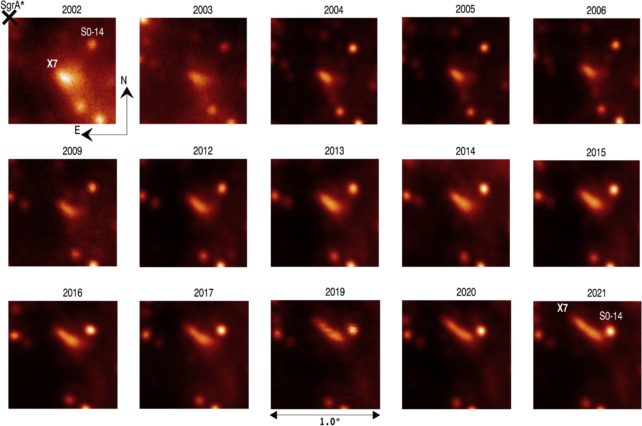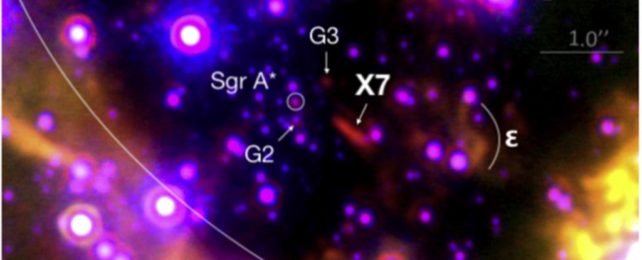For decades, astronomers have watched a mysterious blob named X7 drift around the supermassive black hole at the heart of the Milky Way, wondering where it came from.
By analyzing 20 years' worth of observations, a team of scientists led by University of California Los Angeles astrophysicist Anna Ciurlo has uncovered dramatic transformation in the X7's shape, stretching to almost twice its initial length.
That change in structure suggests the strange blob is most likely made of debris ejected during a relatively recent collision between two stars.
"No other object in this region has shown such an extreme evolution," Ciurlo explains.
"It started off comet-shaped and people thought maybe it got that shape from stellar winds or jets of particles from the black hole. But as we followed it for 20 years we saw it becoming more elongated. Something must have put this cloud on its particular path with its particular orientation."
If a debris cloud is indeed what the object is, its discovery sheds light on some of the fascinating dynamics in the galactic center, such as the frequency of stellar collisions, and the effects of extreme gravity. In just a few short years, the cloud of dust and gas will become more and more spaghettified, and fall into the black hole Sagittarius A* (SgrA*.).
By studying X7 over a period of years, the researchers have been able to calculate its mass, which weighs in at around 50 times that of Earth's. That might be a lot to an Earth resident, but in space it's practically a sneeze, not even equating a sixth of a Jupiter's mass.
Changes in the debris cloud's position and its velocity also suggest that it's on an elliptical orbit around the galactic center, with a period of around 170 years. Or rather, it would be, if it were a bit more together. Simulations suggest that it won't get the chance to complete a single orbit.
Its closest approach to Sgr A*, known as periastron, is projected to occur in 2036. At this point, the gravitational environment will tear the cloud apart, leaving diffuse remnants to continue circling the black hole until they vanish irretrievably beyond its event horizon. When this finally happens, whoever happens to be watching may see some fireworks.
"It's exciting to see significant changes of X7's shape and dynamics in such great detail over a relatively short time scale as the gravitational forces of the supermassive black hole at the center of the Milky Way influences this object," says astronomer and co-author Randy Campbell of Keck Observatory.
X7 shares some similarities with other mystery blobs orbiting the galactic center, known as G objects. These were first discovered around 20 years ago, and posed a significant puzzle: they looked like gas clouds, but behaved like stars, stretching out at periastron, but emerging intact and shrinking back down to a more compact shape to continue their orbits.
Astronomers hypothesized that the G objects were stars that had merged together, producing a huge cloud of material that stayed within the gravitational field of the newly merged star, concealing it from view. Then a study published in 2021 found that one of these objects, G2, was a molecular cloud, concealing three baby stars; but the identities of the others remain unknown.
While there are similarities, X7 is significantly different from the G objects, too. Its evolution has been more dramatic than those of the G objects, in both shape and velocity as it stretches out and accelerates towards Sgr A*.
So X7 may not be the same type of object as the G objects, but it's possible that it's related.

"One possibility is that X7's gas and dust were ejected at the moment when two stars merged," Ciurlo says. "In this process, the merged star is hidden inside a shell of dust and gas, which might fit the description of the G objects. And the ejected gas perhaps produced X7-like objects."
Because X7 isn't being held together by a mass lurking in its center, it's expected to have a much shorter lifespan than the G objects; this could be why others of its kind have not yet been spotted. Meanwhile, the merged star from which X7 puffed could still be out there in the galactic center, on its own separate orbit. The researchers note that its orbit is very similar to that of the G object G3, and propose that G3 could be the parent object.
However, it's currently not easy to rule out other possibilities. X7 could have been a chunk of debris stripped from a larger cloud, for instance. Further observations could help narrow it down.
And, of course, watching X7 should be interesting and rewarding in its own right, as it veers closer and closer towards its doom.
"Continued monitoring of X7 will allow us to closely witness these extreme changes," the researchers write, "ending with the ultimate tidal dissipation of the remnants of this intriguing structure."
The research has been published in The Astrophysical Journal.
